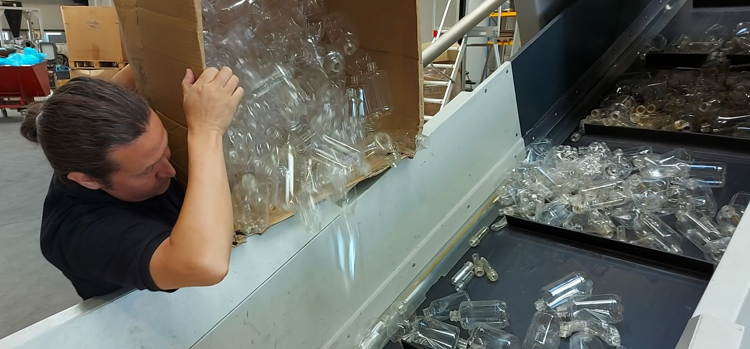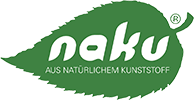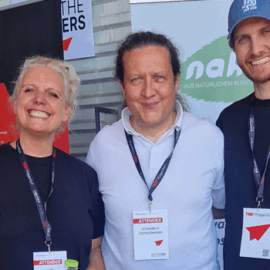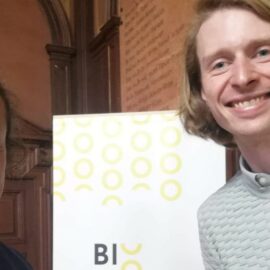
Recycling von PLA/Biokunststoff
Die 120% nachhaltige NaKu PLA/Biokunststoff-Flasche – Recycling von PLA/Biokunststoff
Heute sind wir bei NGR – Next Generation Recycling. Das ist der Spezialist für Recyclingmaschinen und heute werden wir sehen, wie die zu 120 % nachhaltige NaKu-Flasche diese 20 % aus recyceltem Material erhält. Kommen Sie mit uns sehen Sie sich den Recyclingprozess von PLA/Biokunststoff an!
Today we are at NGR Next Generation Recycling. This is the specialist for recycling machines and today we will see how the 120% sustainable Naku bottle will get that 20% of recycled material. Come on and let’s see!
Videoinhalt
Wir sind hier bei NGR, unserem Recyclingspezialisten und Kooperationspartner im Projekt der 120% nachhaltigen Naku-Flasche. Vielen Dank, dass wir heute hier sein dürfen. Wer sind Sie, wer ist NGR, was machen Sie? Mein Name ist Peter Hierzenberger. Ich bin im Labor von NGR und analysiere alle Arten von Kunststoffen. NGR selbst baut Kunststoffrecyclingmaschinen. Es gibt also viele verschiedene Input- und Output-Materialien zu prüfen, die Qualität vor und nach dem Prozess in unseren Maschinen. Was ist nun das Besondere am Recycling von Naku-Flaschen? Naku-Flaschen werden aus PLA hergestellt, einem Biopolymer. Es wurde bereits viel wissenschaftlich an PLA gearbeitet, aber es ist noch nicht so weit in der Industrie angekommen. Es ist also noch ein bisschen neu für uns und für uns sehr spannend, dieses Material zusammen mit NaKu zu untersuchen, um zu prüfen, wie es sich auf unseren Maschinen verhält, wie die Qualität vor und nach der Verarbeitung ist und was aus den von uns recycelten Pellets gemacht werden kann .
We are here at NGR our recycling specialist and cooperation partner in the project of this of the 120% sustainable Naku bottle. Many thanks for for hosting us here. Who are you, who is NGR, what you are doing? My name is Peter Hierzenberger. I’m in the laboratory of NGR and i’m characterizing all kind of plastics. NGR itself is building plastic recycling machines. So there is a lot of different input material and output material to check, the quality before and after the process in our machines. What is now special about recycling Naku bottles? Naku bottles are made from PLA which is a biopolymer. There has been a lot of scientific work on PLA already but it is not already arrived in industry that much. So it’s still a little bit new to us and for us it’s very exciting to investigate this material together with NaKu to check how it behaves on our machines, how is the quality before and after processing and what can be made out of the pellets we recycled.
Für unsere zu 120 Prozent nachhaltige NaKu-Flasche haben wir zwei Möglichkeiten, das Recycling durchzuführen. Wir haben das physikalische Recycling oder das chemische Recycling. Hier sehen Sie das physische Recycling. Physisches Recycling bedeutet, dass wir die Flaschen nehmen, sie reinigen, sie in Stücke, in Flakes shreddern. Dann werden die Flocken wieder zu Pellets geschmolzen und mit den Pellets können wir unsere neuen Flaschen herstellen. Die zweite Option wäre das chemische Recycling. Beim chemischen Recycling nehmen wir das Flaschenmaterial, wir zerlegen es in seine chemischen Bestandteile, aus denen es besteht, wir repolymerisieren es und dann haben wir neuen Rohstoff, um unsere Flaschen herzustellen. Die Vision von NaKu ist, nicht nur 120 Prozent zu haben, wir wollen zweihundert Prozent haben. Hundert Prozent nachwachsend und hundert Prozent recycelt.
For our 120 percent sustainable NaKu bottle we have two options to make the recycling. We have the physical recycling or the chemical recycling. Here you can see the physical recycling. Physical recycling means we are taking the bottles, they are cleaned, they are threaded into pieces, into flakes. Then the flakes are re-melted to pellets and with the pellets we can make our new bottles from. The second option would be the chemical recycling. With chemical recycling we are taking the bottle material, we are breaking it down to its chemical substances where it came from, we are re-polymerizing it and then we have new raw material to make our bottles. Of course if we have this two cycles the far vision that we have is not only to have hundred twenty percent we want to have two hundred percent. Hundred percent regrowable and hundred percent recycled.
Hier sind wir an unserer Recyclingmaschine. Sie hat eine Kapazität von etwa einer halben Tonne pro Stunde und hier sehen wir, wie die nachwachsende NaKu-Flasche recycelt wird. Zuerst geht es das Förderband hinauf zum Schredder, wo es in den Shredder fällt. Dann wird es zu Flakes zerkleinert und die Flakes fallen in den Extruder, wo sie erhitzt und geschmolzen werden.
Here we are at our recycling machine. It has a capacity of about half a ton per hour and here we will see how the NaKu regrowable bottle will be recycled. First it is going up the conveyor belt up to the shredder where it’s falling into the shredder. Then it will be shredded into flakes and the flakes will fall into the extruder where they are heated up and melted.
Hier in diesem Gehäuse haben wir den Extruder und im Inneren des Extruders befindet sich nun das geschmolzene Flaschenmaterial. Wir haben zwei Stationen, um sicherzustellen, dass sich keine anderen Substanzen im Flaschenmaterial befinden. Das erste ist das Vakuum, wo wir alle flüssigen Substanzen herausgefiltert haben und dann die Schmelze zu diesem Filter weitergeht und dieser Filter alle nicht geschmolzenen Partikel entfernt. Wir haben hier den Filter. Jetzt hat das Material alle Reinigungsschritte bestanden und kommt hier heraus. Normalerweise können wir das hier nicht sehen, wenn die Maschine läuft, weil sie jetzt getrennt ist, aber im laufenden Prozess sind die beiden Teile geschlossen. Die heiße saubere Schmelze kommt hier heraus, sie wird geschnitten. Wir haben Wasser im Gehäuse und das Wasser befördert die Pellets hier heraus. Hier werden sie durch Zentrifugieren getrennt, dabei werden Wasser und Pellets getrennt und hier kommen die Biokunststoff-Pellets heraus. Wir haben nun hundertprozentig recyceltes PLA-Material. Hier kommt das zu 100% recycelte PLA NaKu-Flaschenmaterial heraus, bereit, eine neue Biokunststoff NaKu-Flasche zu werden.
Here in this casing we have the extruder and inside of the extruder is now the melted bottle material. We have two stations to be sure that there are no other substances in the bottle material. The first is the vaccum where we have vaccum tiering all alt liquid substances and then melt goes going forward to this filter and the filter is taking out all not melted particles. We have here the filter. Now the material has passed all cleaning step and it will come out out here. Normally we cannot see this here when the machine is running because now it’s separated but in running process they are together. The hot clean melt is coming out here, it is cut. We have water inside and the water takes the pellets out here. Here they are separated via centrifugation where water and pellets are separated and pellets are coming out here and here we have hundred percent recycled pla material. Here the 100 recycled NaKu bottle material is coming out ready to be a new bottle.



